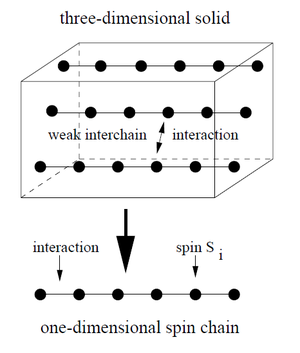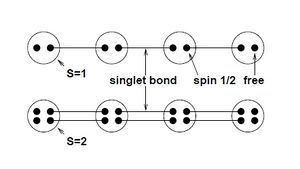S=1/2 and S=1 one dimensional quantum magnets
Why are we interested in one-dimensional magnetism? Magnetism in one dimension are of highly theoretical interest as well as there are a variety of highly interesting experimental systems. Most two-dimensional magnets order at T=0, however, in one-dimensional situation, fluctuations are so strong that at T=0 most magnets are disordered. Because of the strong fluctuations, conventional techniques are normally not applicable. So we need to search for new tools to solve these problems. One of the representative way is to use numerical methods. An example is, by numerically evaluation, one found a unique, disorder ground state of the nearest-neighbor isotropic anti-ferromagnetic Heisenberg chain for spins S=1/2, with anti-ferromagnetic spin-spin correlations, referred as quasi long-range ordered.In theoretical research, Coherent many body wave functions are fascinating and useful in situations of quantum magnets without static order at T=0.

Haldane's Conjecture
Introduction to Haldane's Conjecture
Haldane conjectured a fundamental difference between spin chains with S an integer and S a half-integer. Haldane Conjecture is that there is a spin gap of the excitation spectrum in integer Heisenberg spin chains whereas half-integer spin chains have a gapless excitation spectrum. Here we use effective field theories of anti-ferromagnets to show Haldane's Conjecture.
Effective Field Theories of Antiferromagnets
Let's consider an isotropic anti-ferromagnetic Heisenberg model with nearest neighbor interaction between spins of S length.The Hamiltonian can be expressed as
- Failed to parse (SVG (MathML can be enabled via browser plugin): Invalid response ("Math extension cannot connect to Restbase.") from server "https://wikimedia.org/api/rest_v1/":): {\displaystyle \mathcal{H}=J\sum_{i=1}^N \mathbf{S}_i \mathbf{S}_j \qquad J>0}
Assume that local Failed to parse (SVG (MathML can be enabled via browser plugin): Invalid response ("Math extension cannot connect to Restbase.") from server "https://wikimedia.org/api/rest_v1/":): {\displaystyle N\acute{e}el} order on short length scales, we can derive an effective long-wavelength low energy Lagrangian for Failed to parse (SVG (MathML can be enabled via browser plugin): Invalid response ("Math extension cannot connect to Restbase.") from server "https://wikimedia.org/api/rest_v1/":): {\displaystyle S\rightarrow\infty}
- Failed to parse (SVG (MathML can be enabled via browser plugin): Invalid response ("Math extension cannot connect to Restbase.") from server "https://wikimedia.org/api/rest_v1/":): {\displaystyle \mathcal{L}=\frac{v}{2g}\partial_{\mu}\overset{\rightarrow}{\phi}\partial^{\mu}\overset{\rightarrow}{\phi}+\frac{\Theta}{8\pi}\epsilon^{\mu\nu}\overset{\rightarrow}{\phi}\left(\partial_{\mu}\overset{\rightarrow}{\phi}\times\partial_{\mu}\overset{\rightarrow}{\phi} \right)}
Where v=2JS is the spin wave velocity, g=2/S is the coupling constant and Failed to parse (SVG (MathML can be enabled via browser plugin): Invalid response ("Math extension cannot connect to Restbase.") from server "https://wikimedia.org/api/rest_v1/":): {\displaystyle \Theta=2\pi S} is the topological angle; Failed to parse (SVG (MathML can be enabled via browser plugin): Invalid response ("Math extension cannot connect to Restbase.") from server "https://wikimedia.org/api/rest_v1/":): {\displaystyle \overset{\rightarrow}{\phi}} is a three-component unit vector field. Then we can do a Wick rotation to get the form of Lagrangian as below:
- Failed to parse (SVG (MathML can be enabled via browser plugin): Invalid response ("Math extension cannot connect to Restbase.") from server "https://wikimedia.org/api/rest_v1/":): {\displaystyle \mathcal{L}=\mathcal{L}_{NL}+i\mathcal{L}_{TOP}}
Where Failed to parse (SVG (MathML can be enabled via browser plugin): Invalid response ("Math extension cannot connect to Restbase.") from server "https://wikimedia.org/api/rest_v1/":): {\displaystyle \mathcal{L}_{NL}} is the Lagrangian of an O(3) nonlinear Failed to parse (SVG (MathML can be enabled via browser plugin): Invalid response ("Math extension cannot connect to Restbase.") from server "https://wikimedia.org/api/rest_v1/":): {\displaystyle \sigma} model and Failed to parse (SVG (MathML can be enabled via browser plugin): Invalid response ("Math extension cannot connect to Restbase.") from server "https://wikimedia.org/api/rest_v1/":): {\displaystyle \mathcal{L}_{TOP}=\frac{\Theta}{8\pi}\epsilon^{\mu\nu}\overset{\rightarrow}{\phi}\left(\partial_{\mu}\overset{\rightarrow}{\phi}\times\partial_{\mu}\overset{\rightarrow}{\phi} \right)} .With differential geometry, we are able to derive that
- Failed to parse (SVG (MathML can be enabled via browser plugin): Invalid response ("Math extension cannot connect to Restbase.") from server "https://wikimedia.org/api/rest_v1/":): {\displaystyle Q[\overset{\rightarrow}{\phi}]=\frac{1}{\Theta}\int{d^2 x}\mathcal{L}_{TOP}[\overset{\rightarrow}{\phi}]}
Here Q is an integer for any field Failed to parse (SVG (MathML can be enabled via browser plugin): Invalid response ("Math extension cannot connect to Restbase.") from server "https://wikimedia.org/api/rest_v1/":): {\displaystyle \overset{\rightarrow}{\phi}} . It's called winding number.
The partition function is
- Failed to parse (SVG (MathML can be enabled via browser plugin): Invalid response ("Math extension cannot connect to Restbase.") from server "https://wikimedia.org/api/rest_v1/":): {\displaystyle Z=\int D[\overset{\rightarrow}{\phi}]e^{-\int{d^2 x}\mathcal{L}_{NL}}e^{-i\Theta Q[\overset{\rightarrow}{\phi}]}\delta\left( |\overset{\rightarrow}{\phi}|^2 \right)}
Failed to parse (SVG (MathML can be enabled via browser plugin): Invalid response ("Math extension cannot connect to Restbase.") from server "https://wikimedia.org/api/rest_v1/":): {\displaystyle e^{-i\Theta Q[\overset{\rightarrow}{\phi}]}= \begin{cases} 1 & S=interger \\ \pm 1 & S=half-interger \\ \end{cases} }
For integer S, it's reduced to the nonlinear Failed to parse (SVG (MathML can be enabled via browser plugin): Invalid response ("Math extension cannot connect to Restbase.") from server "https://wikimedia.org/api/rest_v1/":): {\displaystyle \sigma} -model. And for half-integer S,it can be considered by the Bethe ansatz for S=1/2.
Re-normalize group, we can get the below Failed to parse (SVG (MathML can be enabled via browser plugin): Invalid response ("Math extension cannot connect to Restbase.") from server "https://wikimedia.org/api/rest_v1/":): {\displaystyle \beta} function.
- Failed to parse (SVG (MathML can be enabled via browser plugin): Invalid response ("Math extension cannot connect to Restbase.") from server "https://wikimedia.org/api/rest_v1/":): {\displaystyle \beta\left( \mu \right)=a\frac{du}{da}=-\epsilon u+\frac{u^{2}}{2\pi}+O\left( u^{3} \right)}
This function tells us that for any finite S, the flow is to disordered high-temperature limit. Where we regard Failed to parse (SVG (MathML can be enabled via browser plugin): Invalid response ("Math extension cannot connect to Restbase.") from server "https://wikimedia.org/api/rest_v1/":): {\displaystyle u=ga^{2-d}} ,lattice constant a and Failed to parse (SVG (MathML can be enabled via browser plugin): Invalid response ("Math extension cannot connect to Restbase.") from server "https://wikimedia.org/api/rest_v1/":): {\displaystyle \epsilon=d-2} .
The correlations are antiferromagnetic. They decay with the Ornsterin-Zernike law for two-dimensional space-time.
- Failed to parse (SVG (MathML can be enabled via browser plugin): Invalid response ("Math extension cannot connect to Restbase.") from server "https://wikimedia.org/api/rest_v1/":): {\displaystyle \left\langle \mathbf{S}_i\cdot\mathbf{S}_j \right\rangle\propto\left( -1 \right)^{i-j}\frac{e^{-|i-j|/\xi}}{\sqrt[2]{|i-j|}}}
For Failed to parse (SVG (MathML can be enabled via browser plugin): Invalid response ("Math extension cannot connect to Restbase.") from server "https://wikimedia.org/api/rest_v1/":): {\displaystyle k\simeq\pi} , the excitation spectrum is massive-relativistic, with a gap to the ground state and can be depicted as
- Failed to parse (SVG (MathML can be enabled via browser plugin): Invalid response ("Math extension cannot connect to Restbase.") from server "https://wikimedia.org/api/rest_v1/":): {\displaystyle E\left( k \right)=\sqrt[2]{\Delta^{2}+v^{2}\left( k-\pi \right)^2}}
In the limit of Failed to parse (SVG (MathML can be enabled via browser plugin): Invalid response ("Math extension cannot connect to Restbase.") from server "https://wikimedia.org/api/rest_v1/":): {\displaystyle S\rightarrow\infty} , the finite gap and the correlation length should have the relation with S, demonstrated like
- Failed to parse (SVG (MathML can be enabled via browser plugin): Invalid response ("Math extension cannot connect to Restbase.") from server "https://wikimedia.org/api/rest_v1/":): {\displaystyle \Delta\left( S \right) \propto S^2e^{-\pi S}}
- Failed to parse (SVG (MathML can be enabled via browser plugin): Invalid response ("Math extension cannot connect to Restbase.") from server "https://wikimedia.org/api/rest_v1/":): {\displaystyle \xi\left( S \right) \propto S^{-1}e^{\pi S}}
In classic limit, at T=0, Failed to parse (SVG (MathML can be enabled via browser plugin): Invalid response ("Math extension cannot connect to Restbase.") from server "https://wikimedia.org/api/rest_v1/":): {\displaystyle \lim_{S \to \infty }\Delta=0} ,Failed to parse (SVG (MathML can be enabled via browser plugin): Invalid response ("Math extension cannot connect to Restbase.") from server "https://wikimedia.org/api/rest_v1/":): {\displaystyle \lim_{S \to \infty }\xi=0}
Verify Haldane's Conjecture in S=1/2 case: the Bethe solution for S=1/2
From Reference [2],we can get a view of Bethe solution for S=1/2
The Bethe solution for S=1/2 states that for a rather large class of isotropic, translationally and rotationally invariant Hamiltonians, the spectrum is either critical, or the ground state degenerate with broken translational invariance, for example, by dimerisation, and the spectrum gapped. This indicate that the S=1/2 chain is indeed generic for all half-integer spins.
Verify Haldane's Conjecture in S=1 case
For integer spins, there is no exact analytic result. For S=1, many studies have been carried out to determine the gap, converging to Failed to parse (SVG (MathML can be enabled via browser plugin): Invalid response ("Math extension cannot connect to Restbase.") from server "https://wikimedia.org/api/rest_v1/":): {\displaystyle \Delta_{s=1}=0.41050\left( 2 \right)} obtained independently by DMRG and exact diagonalization. Experimentally, the gap was first confirmed beyond any doubt by Renard et al.[3], on the standard S=1 chain “NENP” (Failed to parse (SVG (MathML can be enabled via browser plugin): Invalid response ("Math extension cannot connect to Restbase.") from server "https://wikimedia.org/api/rest_v1/":): {\displaystyle [Ni\left( C_{2}H_{8}N_{2} \right)_{2}][ClO_{4}]} ). The experiments showed isotropic interactions with a weak easy-plane anisotropy, which agreed with theoretical results very well.
Nevertheless, we can comprehend in another simple way about the spin gap of spin 1 AFM (antiferromagnet). As displayed in Fig_3, Magnets with 2S=nz have a nearest neighbor singlet covering. For integer spin chains (S=n, z=2) this state is “close to” the ground state, Excited states are propagating bond triplets separated from the ground state by an energy gap.
Microscopic Description of Haldane Magnets: AKLT model
Affleck-Kennedy-Lieb-Tasaki(AKLT) model has explained why excitation are gapped from a microscopic point of view. The AKLT Hamiltonian for a spin chain with spin S=1 is:
- Failed to parse (SVG (MathML can be enabled via browser plugin): Invalid response ("Math extension cannot connect to Restbase.") from server "https://wikimedia.org/api/rest_v1/":): {\displaystyle H^{ALKT}_{S1}=\sum_{i}\overset{\rightarrow}{S_i}\cdot\overset{\rightarrow}{S_i+1}+\frac{1}{3}\left( \overset{\rightarrow}{S_i}\cdot\overset{\rightarrow}{S_i+1} \right)^2+\frac{2}{3}}
Here we can obtain a bilinear-biquadratic spin chain.

Fig_2 describes the valence bond solid ground state Failed to parse (SVG (MathML can be enabled via browser plugin): Invalid response ("Math extension cannot connect to Restbase.") from server "https://wikimedia.org/api/rest_v1/":): {\displaystyle |\psi^{VBS}>} . From Fig_5, it's easy to see that the maximal spin sum on each bond is S and we have Failed to parse (SVG (MathML can be enabled via browser plugin): Invalid response ("Math extension cannot connect to Restbase.") from server "https://wikimedia.org/api/rest_v1/":): {\displaystyle H^{ALKT}|\psi^{VBS}>=0} . The symmetric spins are linked by singlet bonds Failed to parse (SVG (MathML can be enabled via browser plugin): Invalid response ("Math extension cannot connect to Restbase.") from server "https://wikimedia.org/api/rest_v1/":): {\displaystyle \frac{1}{\sqrt[]{2}}\left( |\uparrow\downarrow>-|\downarrow\uparrow> \right)} . Since Failed to parse (SVG (MathML can be enabled via browser plugin): Invalid response ("Math extension cannot connect to Restbase.") from server "https://wikimedia.org/api/rest_v1/":): {\displaystyle H^{ALKT}} is a positive sum of projectors, so it doesn't have negative eigenvalues, which leads us to find the ground state.
In fact, with the S=1 case, we can see how the property of both chains are continuously connected[4]
However, it exists limit. The T=0 phase diagram in the semi-classical limit Failed to parse (SVG (MathML can be enabled via browser plugin): Invalid response ("Math extension cannot connect to Restbase.") from server "https://wikimedia.org/api/rest_v1/":): {\displaystyle S\rightarrow\infty} is gotten by the replacement of the quantum spins by commuting unit vector spins.
For half-integer spins, the phase diagram of S=1/2 and S=infinite are very similar, so the classical limit for half-integer is very obvious. However, for S=1 situation, phase diagram is very different. It's not trivial.
Comparison between Heisenberg model and AKLT model
Heisenberg model and AKLT model are both from the Hamiltonian
Failed to parse (SVG (MathML can be enabled via browser plugin): Invalid response ("Math extension cannot connect to Restbase.") from server "https://wikimedia.org/api/rest_v1/":): {\displaystyle H\left( \alpha \right)=cos\gamma\sum_{i}\overset{\rightarrow}{S_i}\cdot\overset{\rightarrow}{S_i+1}+sin\gamma\sum_{i}\left( \overset{\rightarrow}{S_i}\cdot\overset{\rightarrow}{S_i+1} \right)^2}
The difference is in Hersenberg model, Failed to parse (SVG (MathML can be enabled via browser plugin): Invalid response ("Math extension cannot connect to Restbase.") from server "https://wikimedia.org/api/rest_v1/":): {\displaystyle \gamma=0} , while in AKLT model Failed to parse (SVG (MathML can be enabled via browser plugin): Invalid response ("Math extension cannot connect to Restbase.") from server "https://wikimedia.org/api/rest_v1/":): {\displaystyle \gamma=0.1024\pi} .
Numerical Method to Solve 1-D Quantum Magnets Problem: DMRG
The word DMRG is short for The Density Matrix Renormalization Group.
Various techniques have been introduced or greatly refined: the nonlinear-model, conformal analysis, bosonization, the matrix product ansatz, the Bethe ansatz, exact diagonalization and quantum Monte Carlo are now standard techniques in the field. Among numerical approaches, certainly the most important recent development has been the introduction of the Density Matrix Renormalization Group (DMRG) by White in 1992. It's an effective approach to open one-dimensional quantum magnets paradox.
References
- ↑ 1.0 1.1 Ulrich Schollw¨ock. One-dimensional Quantum Spin Systems. [1], 1998.
- ↑ E. Lieb, T. Schultz, D. Mattis, Ann. Phys. (N.Y.) 16, 407, 1961.
- ↑ J.P. Renard, M. Verdaguer, L.P. Regnault, W.A.C. Erkelen, J. Rossat-Mignod, W.G. Stirling, Europhys. Lett. 3, 945 (1987).
- ↑ U. Schollw¨ock, Th. Jolicoeur, Th. Garel. Phys. Rev. B 54, 3304 (1996).
